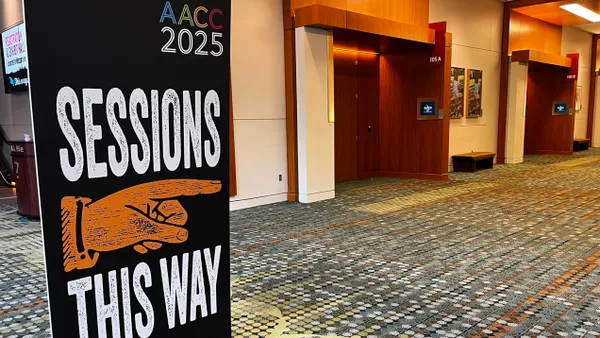Dive Brief:
- Specialized informational materials and offers of one-on-one advising did not affect veterans' decisions about whether and where to enroll in college, persist while there or use GI Bill education benefits, according to a new working paper published by the National Bureau of Economic Research.
- The results indicate low-intensity recruitment strategies are unlikely to work on nontraditional students with similar characteristics to veterans.
- Researchers also found that a lack of information is not what drives veterans to disproportionately enroll at colleges with poor student outcomes.
Dive Insight:
Students are more likely to graduate when they attend high-quality colleges. And students are more likely to apply to and enroll at those colleges when they are clearly told they can attend tuition free, according to the paper, which has not been peer reviewed. Under the GI Bill, veterans can attend many colleges for a net cost of $0.
From March 2016 to November 2017, researchers studied 13,173 active-duty service members without college degrees who were transitioning back to civilian life. Each soldier scored at the 65th percentile or above on the Armed Forces Qualification Test, part of a standardized test used by the military to assess candidates' enlistment eligibility.
A randomized control trial split the service members into three groups: those who received information and the option of professional college advising, those who just received the information, and a control group who didn’t receive either.
Researchers sought to match returning service members with quality colleges near them through personalized mail, emails and text messages. The communications began once service members started the formal process of separating from the military, approximately a year before they left.
The materials highlighted that veterans would likely pay a net price of $0 at most colleges without additional financial aid forms. They also included information about on-campus student veterans’ groups and contact information for their leaders.
Veterans were more likely to engage with open-ended messages that appeared to be sent by an individual than generic messages that came from an organization, researchers found. Text messages from someone who identified as a college adviser working with the Army got responses from two-thirds of veterans. Their replies averaged 158 characters across four messages. That's compared to a 17% response rate from the group that only got generic information, with an average response of 24 characters across three messages.
But the findings indicate a more casual communication method may not be enough to overwrite aggressive veteran recruitment from for-profit institutions.
For-profit colleges invest heavily in recruiters, especially those with sales backgrounds, according to the paper. It also says for-profits apply strong pressure to hit enrollment quotas.
More assertive policies, like tying financial aid to colleges' performance, may be needed to improve higher education outcomes among veterans and the broader nontraditional student population, the researchers wrote.














